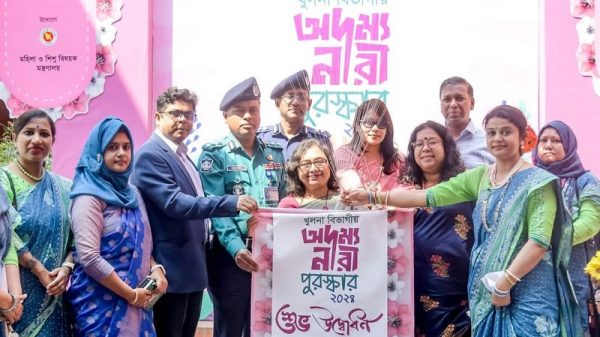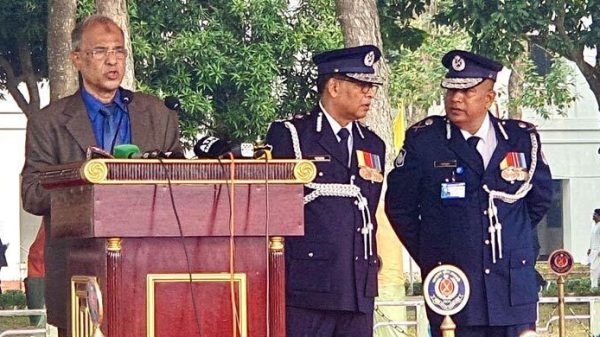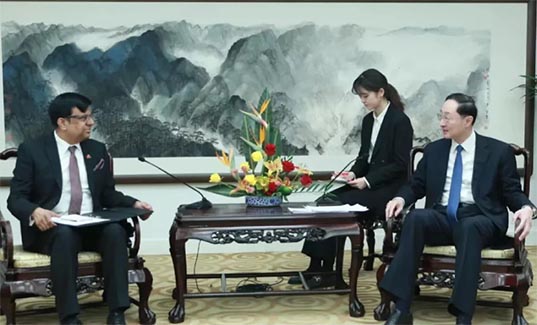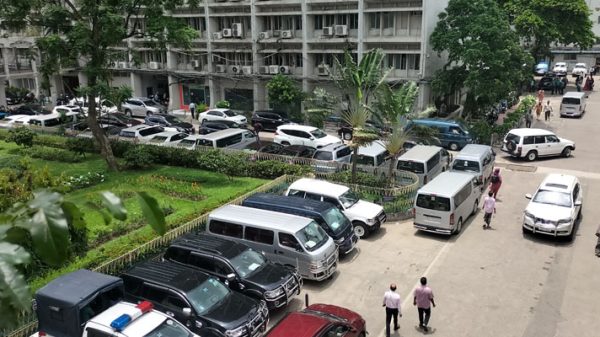Green Roofs in Dhaka City: Pathway to Smart Urban Agriculture

- Update Time : Tuesday, 14 November, 2023, 08:21 pm
- 206 Time View
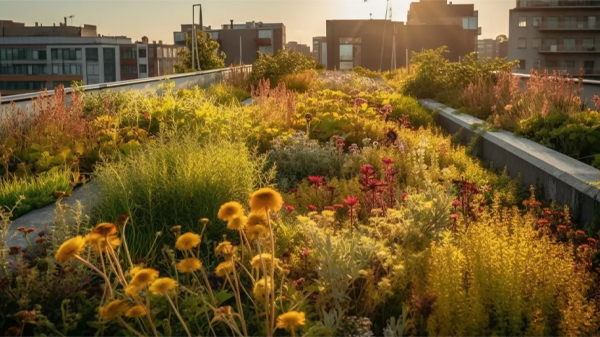
Online Desk: When the roof or terrace of a building is covered with plants such as trees, shrubs, bushes, and grass, it is termed as a roof garden. This farming practice is also known as, terrace farm, rooftop farm, rooftop garden, green roof, living roof, or eco-roof.
The concept of Smart urban agriculture focuses on adequate production of crops, vegetables and fruits utilising advanced farming techniques along with IoT and AI.
As Dhaka has scarcity of arable land, the methods of smart agriculture can be applied here through terrace farming. Let’s take a look into the prospects of smart rooftop farming in Dhaka city.
Threats to the Food System of Dhaka City
Decreasing Arable Land
To cope up with the increasing pressure of population, the agricultural lands are being converted to residential, commercial or industrial land uses. Such practices are reducing the scope of growing agricultural food products in different urban areas of Bangladesh including the Dhaka metropolitan city.
Rising Food Inflation
One of the major impacts of the Russia-Ukraine crisis was the disruption of global trades of some key foods and agricultural commodities. Like many other countries, Bangladesh has been experiencing rising prices of foods and agricultural products which is threatening the country’s food security. According to BBS data, the food inflation rate in Bangladesh climbed to 12.54% in August 2023. The demands and prices of food commodities are also rocketing in Dhaka city.
Harmful Chemicals
The usage of inorganic fertilisers and harmful pesticides to increase agricultural productions are making the yields hazardous for human health. Furthermore, food contamination practices such as application of harmful chemicals to ripen fruits or keep vegetables fresh for long hours are posing threat to the health of Dhaka city residents.
Multifarious Benefits of Terrace Farming for Dhaka City
Rooftop farming can contribute to minimising the impacts of the above-mentioned problems.
– The unused areas of buildings-tops can be transformed into productive farms.
– Fresh, organic, and hygienic food products can be grown on the terrace areas to fulfil the daily needs of families.
– Home-grown fruits and vegetables can reduce food expenses. Therefore, the practice of growing their own food can help households to save money.
The additional benefits of terrace gardening are as follows.
– Dhaka often ranks top on the list of cities worldwide with the worst air quality. Plantations can help to create a healthy urban atmosphere by improving air quality, absorbing carbon dioxide, and lessening the impact of global warming.
– Green roofs are capable of harnessing the cooling power of trees, plants, and herbs to reduce the temperature of the built environment.
– Ecological impacts of plants can help to create new habitats for birds and insect pollinators, such as bees, butterflies, etc.
– Due to unplanned urbanisation, many areas of Dhaka city lack enough spaces for socialisation. However, city residents can spend some quality time with family members or neighbours if there are gardens on their terraces.
– Gardening can help to increase levels of the two “happy” hormones, dopamine and serotonin. Besides lifting the mood, gardening can help city residents get rid of anxieties.
Smart Rooftop Farming: Some Innovative Ways to Grow Plants on Terrace
Extensive or Intensive Green Roof
The green roof systems can be divided into two main categories.
An extensive green roof usually includes a shallow layer of substrate covering a large area. In this lightweight layer, soil depth ranges from 5 to 15 cm (2 to 6 inches) on average. Typically consisting of mosses and herbs, a narrow range of plants are grown here that require low maintenance. Such rooftop gardens need low capital costs and low maintenance requirements.
On the other hand, a deeper layer of substrate is built in smaller areas in an intensive green roof. Here the depth of soil usually ranges from 20 to 60 cm (8 to 24 inches). Besides farming of a variety of plants, intensive green roofs facilitate human recreational uses. While designing such roofs, the architects consider facts such as irrigation, and drainage systems.
Seedling Trays and Raised Planter Boxes
According to the concept of smart rooftop farming, agricultural production systems can be installed in various forms, such as nursery trays or seedling trays, raised crop beds or planter boxes, etc.
The seedling tray method allows growing plants without disturbing their roots. In this method, separate wooden boxes, or smart pot bags are used for each plant. This method facilitates better plant growth and improved disease control.
Besides aesthetic appearances, the raised planter boxes can prevent the growth of weeds. These crop beds allow the flow of water, preventing water stagnation. The cultivator can also control soil quality, water, pest, sun exposure, seasonal extension, etc.
Farming Systems without Soil: Hydroponics, Bioponics and Aeroponics
In terrace farming, the cultivator can opt for high-tech systems, such as hydroponics, aeroponics and bioponics. Hydroponics is a closed loop farming system, where the plants are grown in a water-based nutrient solution rather than soil.
In the case of the bioponics system, the nutrients used in the water are organic and biological.
In the aeroponics farming system, the plants are grown in a nutrient-enriched mist environment instead of soil or water.
In smart urban agricultural practices, the parameters such as water oxygen, pH, temperature, etc. are monitored and controlled to optimise the growth of plants through centralised computer management and IoT.
Hydroponics, and Aeroponics farming system (Image: Linked-In)
Common Methods of Roof Farming in Dhaka City
Forms of Rooftop Plantations
In Dhaka city, the style of rooftop gardening and plantations can be divided into four types depending on their uses and appearances.
– Extensive green roof
– Extensive green roof with some intensive plantation
– Plantation in fixed pots
– Plantation in portable pots
However, intensive green roofs are not very common in Dhaka city.
Common Fruits and Vegetables
Around 60 varieties of fruit and vegetable plants are grown in Bangladesh. Not all of these plants are compatible for rooftop cultivation. In the rooftop gardens plants are chosen depending on several factors such as household food preferences, availability of seed types, soil quality, weather situation, etc.
Research shows about 45 varieties of vegetables and fruits are grown in Dhaka’s rooftop gardens. Tomato, beans, egg plants, brinjal, chilli, spinach, lettuce, okra, different types of gourds, lemon, leafy vegetables, etc are widely grown in Dhaka’s roof gardens.
Besides these, the city’s rooftop farmers can successfully produce fruits like mango, guava, pomegranate, hog-plum, jujubee, papaya, wax apple, malta, sapota, etc.
Scenario of Roof Gardening in Dhaka City
According to the data of Bangladesh Agriculture Information Service (BAIS), more than 450,000 roofs covering above 5,000 hectares are available in Dhaka city. A lion’s share of these roof spaces is left empty. Currently, the capital city has more than 30,000 rooftop gardens that cover above 7% of the total number of building-tops, reports BAIS.
Necessary Modifications to Start Terrace Gardening in a Smart Way
Though the rooftops of buildings in Dhaka City are usually suitable for gardening, some modifications can make them more suitable for growing plants.
– If a building’s layout is designed considering rooftop farming from the initial phase, it can bear the load of soil and plants. Arrangement of necessary facilities such as water taps in different places on the roof.
– A proper plan should be prepared to select low-maintenance plants that are compatible with roof gardens.
– Considering the micro-climate of the area, the cultivators can choose plantation methods, like planting on soil, hydroponics, aeroponics, or bioponics.
– Another step of smart rooftop farming is to find suitable spaces on the roof to place the plantation setups (drums or tubs) as well as the monitoring systems (computer and IoT arrangements).
– The risk of roof dampness due to rooftop farming should not be ignored. To protect the roof from damage, the gardeners can use tubs, drums, or containers for plantations. Bed systems for fruits and vegetables can save the roof from getting damaged.
Some Recommendations to Boost Roof Gardening Practices
Proper measures and incentives from the government or other environmental organisations can boost the practice of smart rooftop farming in Dhaka city.
– Many cities like Tokyo, Austin, Portland, etc have taken policy incentive activities to encourage roof gardening. Following this example, policy incentives can be taken for Dhaka city.
– Provision can be made in the Bangladesh National Building Code (BNBC) to enforce rooftop farming in the new buildings.
– Incentives like density bonuses or FAR (Floor Area Ratio) can be given to encourage the real estate sector as well as building owners to keep the required systems for roof gardens while designing new buildings.
– Moreover, if the government and environmental organisations provide discounts and incentives regarding the price of plants, seeds, and necessary equipment, it may encourage the city residents to initiate rooftop farming.
– The city corporations can offer incentives such as holding tax rebates for the building owners who have green roofs. The Dhaka city corporations have started such an initiative which is praiseworthy.
– Dhaka city dwellers are not very aware of the benefits and process of roof gardening. Coordinated efforts by the government, environmental organisations, and NGOs can be made to disseminate knowledge and training about the beneficial sides along with the technical know-how of smart rooftop farming.

